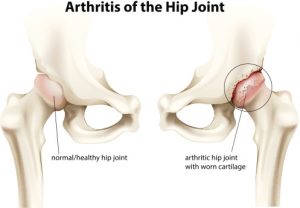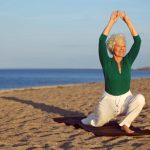 Hip osteoarthritis can cause pain and may not be visible on x-ray. A new study has found that the majority of hip x-rays cannot detect hip osteoarthritis (OA), which can delay treatment of the disease. Hip osteoarthritis is a major cause of morbidity and leads to pain, difficulties walking, and even disability. The prevalence of hip osteoarthritis for those over the age of 60 has doubled in the past 30 years.
Hip osteoarthritis can cause pain and may not be visible on x-ray. A new study has found that the majority of hip x-rays cannot detect hip osteoarthritis (OA), which can delay treatment of the disease. Hip osteoarthritis is a major cause of morbidity and leads to pain, difficulties walking, and even disability. The prevalence of hip osteoarthritis for those over the age of 60 has doubled in the past 30 years.
Researchers looked at 4,500 participants from the Framingham Osteoarthritis and Osteoarthritis Initiative studies. Corresponding author, Dr. Chan Kim, said, “The majority of older subjects with high suspicion for clinical hip osteoarthritis did not have radiographic hip osteoarthritis, suggesting that many older persons with hip osteoarthritis might be missed if diagnosticians relied on hip radiographs to determine if hip pain was due to osteoarthritis.”
Advertisement
Not diagnosing hip osteoarthritis early can lead to serious consequences and, according to Dr. Kim, many patients with OA do not meet the minim requirement for physical activity, which increases the risk of heart or lung disease, diabetes, obesity or falls. Dr. Kim concluded, “Given these findings, patients with suspected hip OA should be treated regardless of x-ray confirmation.”
Causes and symptoms of osteoarthritis of the hip joint
 Osteoarthritis is inflammation and swelling in a joint that leads to pain. Inflammation and injury in a joint can lead to the breakdown of cartilage, which is located at the end of bones between the joints. Cartilage works as a shock absorber so that bones don’t rub together and cause damage. When cartilage does become damaged and wears away, bones can touch and rub together, which not only damages the bones, but leads to a reduction in mobility and more pain.
Osteoarthritis is inflammation and swelling in a joint that leads to pain. Inflammation and injury in a joint can lead to the breakdown of cartilage, which is located at the end of bones between the joints. Cartilage works as a shock absorber so that bones don’t rub together and cause damage. When cartilage does become damaged and wears away, bones can touch and rub together, which not only damages the bones, but leads to a reduction in mobility and more pain.
The hip has a ball and socket joint that allows for a wide range of movement. Because it is a joint it can become susceptible to osteoarthritis.
Although there is no specific cause for hip osteoarthritis, factors that can increase a person’s risk to develop it include:
- Aging
- Family history
- Obesity
- Improper formation of hip joint at birth
Symptoms of hip osteoarthritis include:
- Pain in the groin region that moves to the buttocks or knee
- Pain that flares up during activity
- Stiffness in the hip joint that makes it difficult to walk
- “Locking” or “sticking” of the joint, grinding of the joint
- Decreased range of motion
- Increased pain when it is rainy
Treatment options for osteoarthritis of the hip
Treatment options for hip osteoarthritis include non-surgical and surgical tactics. Non-surgical treatment options include:
- Lifestyle modifications: Minimize activity that aggravates the joint, switch to lower impact exercises and lose weight.
- Physical therapy: PT can help increase range of motion.
- Assistive devices: Using a cane or crutches can help alleviate pressure on the joint.
- Medication: Over-the-counter or prescription medications can help alleviate pain.
Surgical treatments for hip osteoarthritis include:
- Osteotomy: The head of the thighbone or socket is cut to help realign it and alleviate pressure.
- Hip resurfacing: Damaged bone and cartilage is removed and replaced with a metal shell.
- Total hip replacement: The head and the femur are removed and replaced with metal, plastic or ceramic and act as a new hip.
A study has also found that exercise can benefit and help treat hip osteoarthritis. The researchers treated patients over the course of 12 weeks with an exercise program. The exercises were targeted for muscle strengthening, coordination training and to improve mobility.
Advertisement
After the exercise sessions ended, patients reported less pain and more mobility in their joints.
Exercises for osteoarthritis of the hip
Although exercising may seem difficult or even impossible with hip osteoarthritis, it is still essential to help alleviate pain – as long as you are performing the proper exercises. Proper exercises that can help treat hip osteoarthritis include:
 Walking
Walking- Stationary bike
- Water exercises
- Yoga
- Tai chi
- Chair stand (Sit on a chair and raise yourself without using your hands to assist you then sit back down.)
- Hip extension (Holding onto a chair for balance bend forward at the hip and lift a leg up behind you. Stay in this position for a few moments then bring the leg slowly back down and raise up. Perform with each leg.)
- Inner leg stretch (Sit on the floor, bringing your feet in together so the soles touch and your knees are off to the side. Begin to bend forward as if your head were to touch your feet. Hold and bring yourself slowly back up.)
- Double hip rotation (Lie on your back with knees bent and feet on the floor. Slowly bring both knees down to one side of your body, then bring them back to center and dip them to the other side.)
Tips while performing exercises for hip osteoarthritis
There are a few things you need to keep in mind before, during and even after performing exercises when you have hip osteoarthritis. Some helpful tips to ensure you do not injure yourself include:
- Pay attention to your body and if a move doesn’t feel right, do not push yourself to complete it – use modifications if necessary.
- Use gentle, low-impact exercises.
- If pain is increasing, stop and rest – if pain continues after you’re finished, then you have overexerted yourself.
- Use over-the-counter anti-inflammatory medication to alleviate pain.
- Get a good night’s rest – not sleeping well can increase pain.
- Maintain a healthy weight – being overweight adds extra stress to joints.
- Use assistive devices to help alleviate pain.
- Join a club or work with a physiotherapist who will help you improve your flexibility and fitness.
